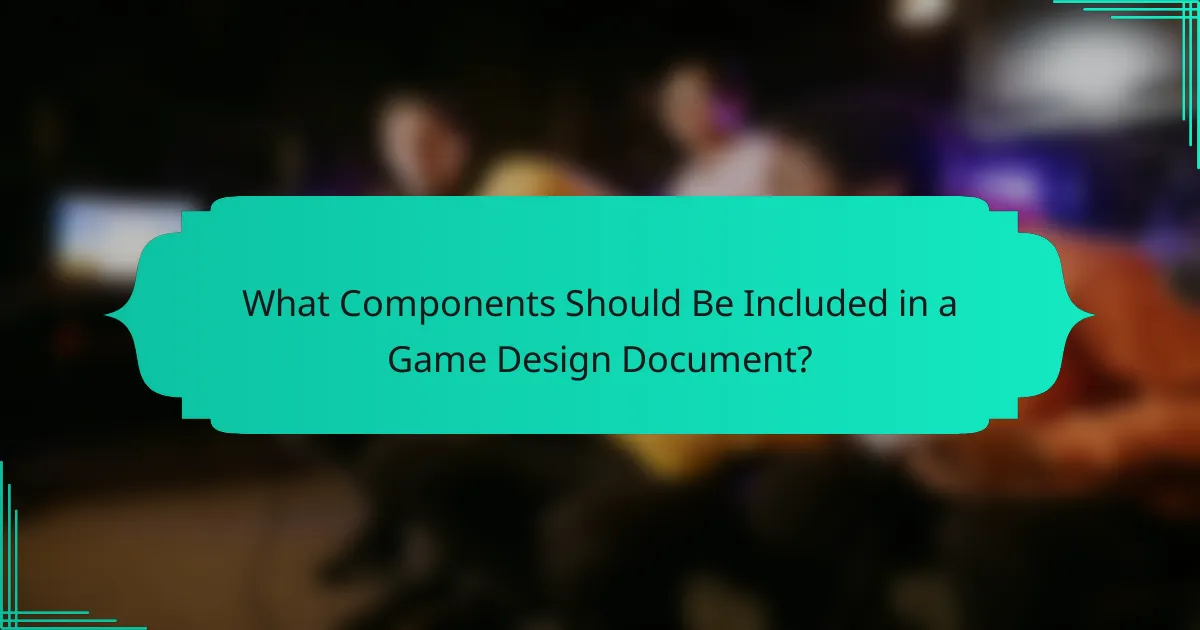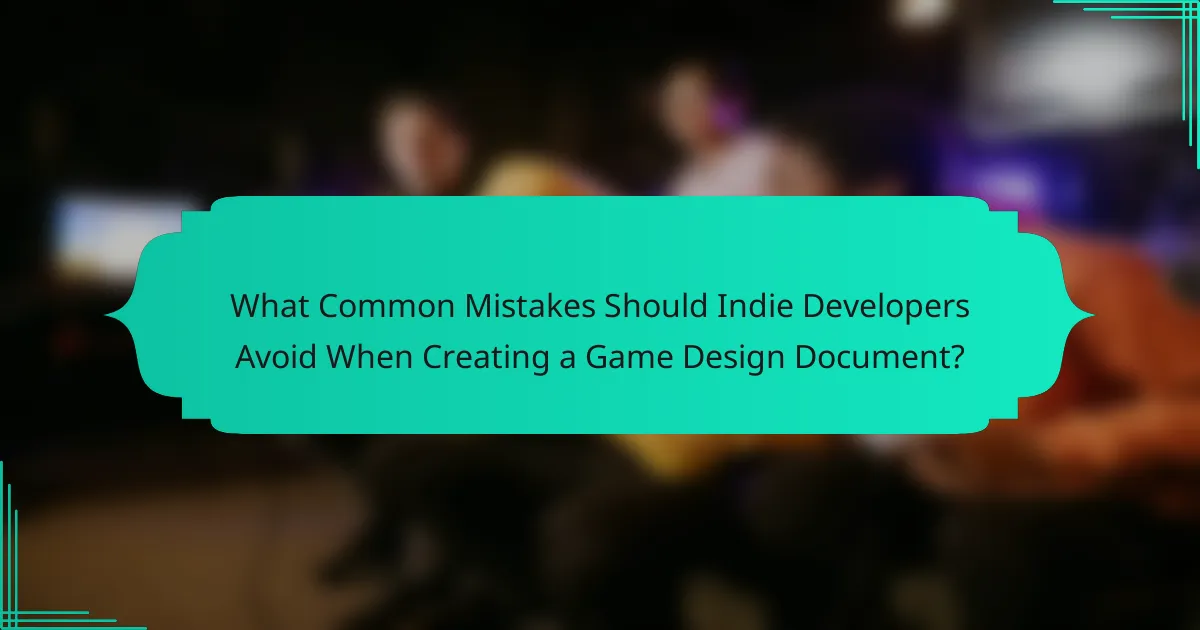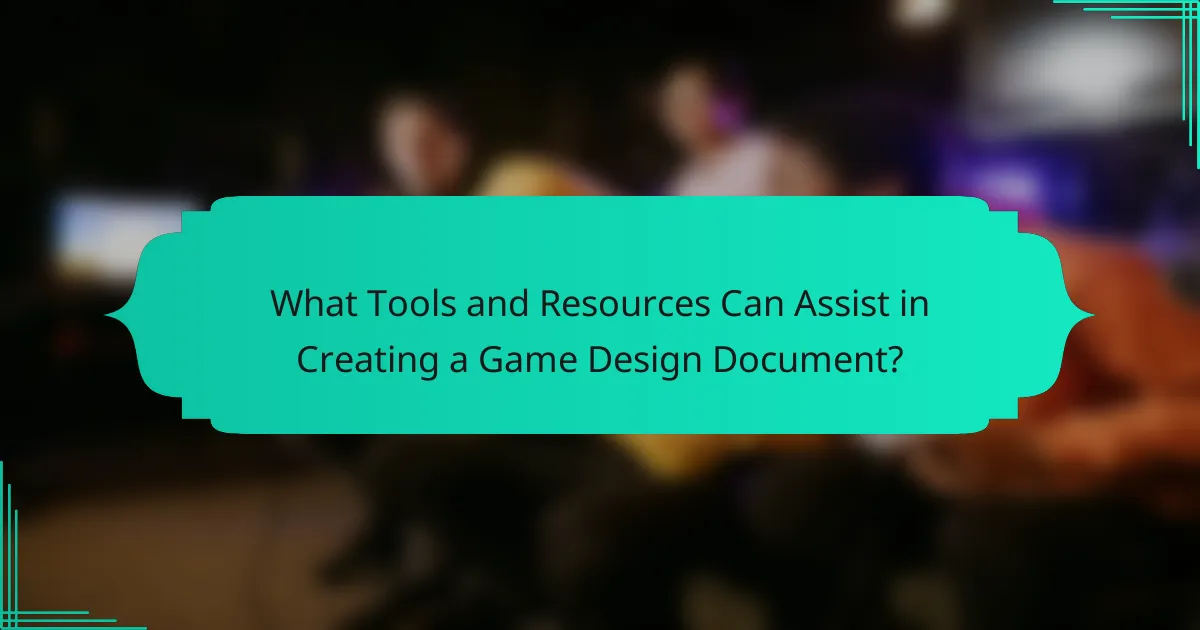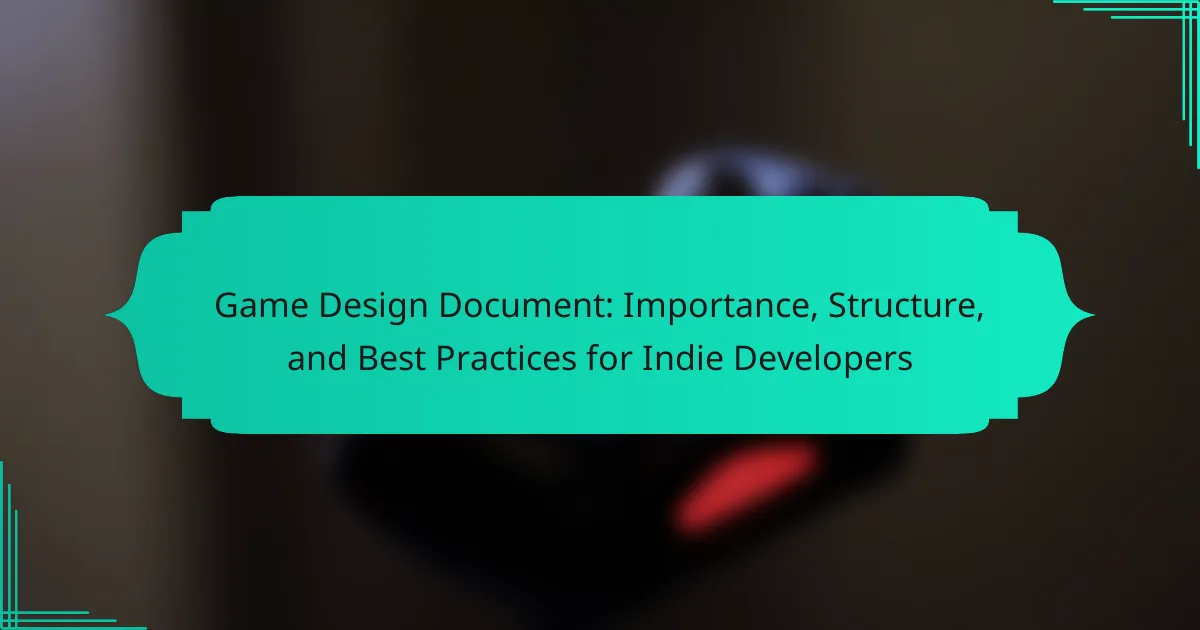A Game Design Document (GDD) is crucial for indie developers to align their team’s vision and streamline the development process. This article explores the importance of a GDD, its essential structure, and best practices for creating an effective document. Key components include game concept, gameplay mechanics, narrative elements, and art style. Additionally, we will discuss tools and methods for keeping the GDD updated throughout the project’s lifecycle.

Why is a Game Design Document Essential for Indie Developers?
A Game Design Document (GDD) is essential for indie developers as it provides a clear roadmap for the game’s vision and development process. It outlines key elements such as gameplay mechanics, story, art style, and target audience, ensuring all team members are aligned.
A well-structured GDD enhances communication and reduces misunderstandings among team members. It serves as a reference point throughout development, allowing for consistent progress tracking and adjustments. Additionally, it helps in pitching ideas to potential investors or collaborators by clearly articulating the game’s unique attributes and market potential.
Best practices for creating a GDD include keeping it concise and organized, using visuals to supplement text, and regularly updating the document as the project evolves. This adaptability is crucial for indie developers who often work with limited resources and need to pivot quickly based on feedback or new ideas.
What Key Benefits Does a Game Design Document Provide?
A Game Design Document (GDD) provides essential benefits such as clarity, organization, and communication among team members. It outlines the game’s vision, mechanics, and art style, ensuring everyone is aligned. A well-structured GDD can enhance project efficiency and reduce misunderstandings. Additionally, it serves as a reference point throughout development, aiding in maintaining focus on the core objectives.
How Does a Game Design Document Facilitate Team Collaboration?
A Game Design Document (GDD) enhances team collaboration by providing a centralized reference point. It outlines the game’s vision, mechanics, and roles, ensuring all team members are aligned.
Clear structure within the GDD fosters communication, allowing designers, developers, and artists to understand their contributions. Regular updates to the document encourage ongoing feedback and adaptations, reinforcing collaborative efforts throughout the development process.
Incorporating visual aids and examples within the GDD can clarify complex ideas, making it easier for team members to grasp concepts quickly. This shared understanding reduces misunderstandings and streamlines decision-making.
Ultimately, a well-crafted GDD serves as a living document that evolves with the project, promoting transparency and accountability among team members.
What Role Does a Game Design Document Play in Project Management?
A Game Design Document (GDD) serves as a blueprint for project management in game development. It outlines the game’s vision, mechanics, and design elements, ensuring all team members are aligned. A well-structured GDD enhances communication, streamlines workflow, and minimizes misunderstandings. It typically includes sections on gameplay mechanics, art style, story, and technical requirements, helping indie developers stay organized and focused. By maintaining clarity and coherence, the GDD plays a crucial role in the successful execution of a game project.

What Components Should Be Included in a Game Design Document?
A Game Design Document should include the following components: game concept, gameplay mechanics, story and characters, art style, technical specifications, and project timeline. Each element contributes to a comprehensive understanding of the game’s vision and requirements.
1. Game Concept: Overview of the game’s theme, genre, and target audience.
2. Gameplay Mechanics: Detailed description of game rules, player interactions, and objectives.
3. Story and Characters: Narrative structure, character development, and setting.
4. Art Style: Visual aesthetics, including character design, environments, and UI elements.
5. Technical Specifications: Required platforms, engine, tools, and performance metrics.
6. Project Timeline: Milestones, deadlines, and resource allocation for development phases.
How to Structure the Core Sections of a Game Design Document?
To structure the core sections of a Game Design Document, focus on clarity and organization. Key sections include the game overview, gameplay mechanics, story and characters, art style, and technical specifications. Each section should provide detailed information relevant to the game’s vision and development process.
1. Game Overview: Summarize the game’s concept, genre, and target audience.
2. Gameplay Mechanics: Outline core gameplay features, controls, and player interactions.
3. Story and Characters: Describe the narrative, setting, and character development.
4. Art Style: Define the visual style, including references and inspirations.
5. Technical Specifications: Detail platform requirements, performance metrics, and tools used.
This structure ensures comprehensive coverage of essential aspects, aiding indie developers in creating a focused and effective document.
Which Visual Elements Enhance a Game Design Document?
Visual elements that enhance a game design document include diagrams, flowcharts, concept art, and mockups. These components provide clarity, improve communication, and facilitate understanding of complex ideas. Visual aids can break down information into digestible parts, making it easier for team members to grasp the game’s vision and mechanics. Including these elements fosters collaboration and ensures everyone is aligned with the design goals.
What Technical Specifications Are Important to Include?
Important technical specifications to include in a Game Design Document (GDD) are game mechanics, platform requirements, art style, sound design, and performance metrics. These elements ensure clarity and direction for development.
| Specification | Description |
|———————-|————————————————–|
| Game Mechanics | Core gameplay systems and interactions |
| Platform Requirements | Target hardware and software specifications |
| Art Style | Visual aesthetics and design guidelines |
| Sound Design | Audio elements, including music and effects |
| Performance Metrics | Expected frame rates and load times |

How Can Indie Developers Tailor Their Game Design Documents for Success?
Indie developers can enhance their game design documents by focusing on clarity, structure, and audience engagement. A well-organized document outlines the game’s vision, mechanics, and narrative, which helps align team efforts and attract potential investors.
Key components include a clear game concept, detailed character descriptions, gameplay mechanics, and visual style references. Each section should be concise yet informative, ensuring essential information is easily accessible.
Incorporating visual aids, such as diagrams and concept art, can also improve comprehension and retain interest. Regular updates and revisions to the document are crucial as the game evolves, reflecting changes in design and scope.
Finally, soliciting feedback from peers and playtesters can provide valuable insights, helping to refine the document and enhance the overall game development process.
What Unique Attributes Should Be Highlighted in a Game Design Document?
A Game Design Document should highlight unique attributes like gameplay mechanics, narrative depth, and visual style. These elements distinguish a game and guide development effectively. Focusing on these aspects ensures clarity and direction for the project. Additionally, emphasizing unique selling points can attract potential players and investors.
Which Best Practices Improve the Quality of a Game Design Document?
To improve the quality of a Game Design Document, focus on clarity, organization, and thoroughness. Key best practices include defining clear objectives, maintaining a structured layout, and incorporating feedback from playtesting.
1. Establish clear goals and objectives for the game.
2. Use a consistent format and structure for easy navigation.
3. Include detailed descriptions of gameplay mechanics and features.
4. Regularly update the document based on team feedback and testing results.
5. Include visual aids like diagrams or prototypes to enhance understanding.
How to Adapt a Game Design Document for Different Platforms?
To adapt a Game Design Document for different platforms, focus on platform-specific requirements and user experiences. Identify unique attributes for each platform, such as control schemes, screen resolutions, and performance capabilities. Tailor content to highlight platform strengths while maintaining core gameplay elements. Ensure that the document includes platform-specific guidelines for distribution and monetization strategies.

What Common Mistakes Should Indie Developers Avoid When Creating a Game Design Document?
Indie developers should avoid common mistakes like lack of clarity, inadequate research, and poor organization when creating a game design document. Clear objectives and thorough research ensure a focused direction. Organizing content logically enhances accessibility and understanding. Additionally, neglecting to include visual aids can diminish the document’s effectiveness.
How Can Overlooking Audience Needs Impact a Game Design Document?
Overlooking audience needs can lead to a game design document that fails to resonate with players. This disconnect can result in poor gameplay experiences, decreased engagement, and ultimately, lower sales. Understanding target audience preferences is essential for shaping game mechanics, narrative, and aesthetics. A well-informed design document aligns development goals with player expectations, ensuring a more successful game launch.
What Are the Risks of Inadequate Documentation in Game Development?
Inadequate documentation in game development can lead to miscommunication, project delays, and increased costs. Without clear guidelines, teams may misinterpret design intentions, resulting in inconsistent gameplay experiences. This can diminish the quality of the final product and frustrate both developers and players. Additionally, lack of documentation makes onboarding new team members difficult, further complicating project timelines.

How to Keep a Game Design Document Updated Throughout Development?
To keep a Game Design Document updated throughout development, regularly review and revise it as the project evolves. Establish a schedule for updates, ideally after key milestones or feedback sessions. Ensure all team members have access and contribute to the document, reflecting changes in gameplay, mechanics, and design decisions. This collaborative approach fosters alignment and clarity, enhancing project coherence. Additionally, utilize version control to track changes, making it easier to revert or reference previous iterations.
What Strategies Ensure Continuous Relevance of a Game Design Document?
Regular updates and stakeholder feedback are crucial for ensuring the continuous relevance of a Game Design Document. Incorporating iterative revisions based on playtesting results and evolving project goals helps maintain alignment with the game’s vision. Establishing a clear communication channel among team members fosters collaboration and adaptability. Additionally, prioritizing user experience and market trends can guide necessary adjustments, ensuring the document remains a valuable resource throughout development.
How to Incorporate Feedback Effectively into a Game Design Document?
Incorporating feedback effectively into a game design document involves a structured approach. First, categorize feedback into actionable items, such as design improvements or gameplay mechanics. Next, prioritize the feedback based on impact and feasibility. Ensure that all team members understand the rationale behind changes to maintain coherence with the original vision. Regularly update the document to reflect these changes, fostering an environment of continuous improvement. Finally, encourage open communication among team members to facilitate ongoing feedback integration.

What Tools and Resources Can Assist in Creating a Game Design Document?
Game design documents can be created using various tools and resources that streamline the process. Popular options include game design software like Unity and Unreal Engine, which offer templates and built-in features for documentation. Additionally, project management tools such as Trello or Asana help organize tasks and collaborate with team members. Online resources like Gamasutra provide articles and examples of effective game design documents, while community forums allow for feedback and sharing best practices among indie developers.
Which Software Solutions Are Best for Indie Developers?
Indie developers benefit from software solutions that streamline game design documentation. Key tools include Trello for task management, Google Docs for collaborative writing, and Unity for game development integration. These solutions enhance organization, facilitate teamwork, and improve project tracking.
How Can Templates Streamline the Game Design Document Process?
Templates can significantly streamline the Game Design Document (GDD) process by providing a structured format that ensures consistency and clarity. They help indie developers organize their ideas, making it easier to communicate vision and goals. Using templates reduces time spent on formatting and allows for focus on content creation, which enhances productivity. Additionally, templates can include essential sections like gameplay mechanics, story elements, and art direction, ensuring that no critical aspect is overlooked. This systematic approach ultimately leads to a more polished and comprehensive GDD, facilitating better collaboration and feedback among team members.

What Expert Tips Can Enhance the Effectiveness of a Game Design Document?
To enhance the effectiveness of a Game Design Document, focus on clarity, organization, and collaboration. Clearly define game mechanics, narrative, and art style to ensure all team members share a unified vision. Organize sections logically, using headings and bullet points for easy navigation. Collaborate with team members for feedback, ensuring the document evolves alongside the project. Regular updates maintain relevance and clarity, making it a living document that adapts to changes.
How to Leverage Community Feedback for Improvement?
To leverage community feedback for improvement, actively engage with your audience and implement their suggestions. Start by creating channels for feedback, such as surveys or forums, and encourage open discussions. Analyze the feedback to identify common themes and prioritize changes that enhance user experience. Regularly update your community on how their input influences your game design document, fostering a collaborative environment.
What Final Touches Make a Game Design Document Stand Out?
To make a game design document stand out, focus on clarity, creativity, and thoroughness. Include a compelling vision statement, detailed character descriptions, and unique gameplay mechanics. Visual elements like concept art and diagrams enhance understanding and engagement. Incorporating a clear structure with sections for narrative, mechanics, and art style ensures easy navigation.
